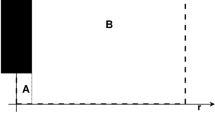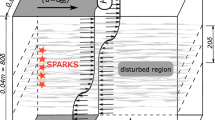Abstract
In today’s internal combustion engines assisted ignition is predominantly achieved by conventional spark ignition. The spark ignition starts with the breakdown phase after which complex flow dynamics govern the energy deposition into the gas. The condition of the activated plasma kernel resulting from spark breakdown, among others, is important for the development of the flame kernel to a self-sustained flame. A simple thermodynamic model is formulated based on insight gained from available detailed plasma simulations and experiments. Under the assumption that the problem is cylinder symmetrical and that the breakdown energy is supplied quasi-instantaneously as a line source, the extent of the hot plasma kernel and the time for pressure equalization with the surrounding can be given by exploiting the properties of radially expanding blast waves. The so-defined control volume is treated as an open system, and a simple energy balance leads to a relation for the mean kernel temperature. The plasma volumes and mean temperatures predicted by this simple model are shown to correspond well with published results in the open literature based on full plasma simulations of the spark discharge available for pressures ranging from 1 to 8 bar. The model allows drawing some conclusions about the requirements for experimental methods, such as calorimetry, frequently used to characterize the efficacy of the spark discharge produced by ignition systems and the influence of pressure and breakdown energy on kernel volume and temperature.






Similar content being viewed by others
Abbreviations
- \(B\) :
-
Energy parameter
- \(c\) :
-
Speed of sound
- \(d\) :
-
Electrode gap
- \(e\) :
-
Internal energy
- \(E\) :
-
Energy
- \(h\) :
-
Specific enthalpy
- \(m\) :
-
Mass of plasma kernel
- \(M\) :
-
Mach number
- \(p\) :
-
Pressure
- \(\dot{Q}\) :
-
Heat flux
- \(r\) :
-
Dimensional radius
- \(t\) :
-
Dimensional time
- \(T\) :
-
Temperature
- \(v\) :
-
Flow velocity
- \(V\) :
-
Volume
- \(0\) :
-
Undisturbed initial state, environment
- \({\text{a}}\) :
-
Activated volume (hot plasma kernel)
- \({\text{br}}\) :
-
Breakdown
- \({\text{c}}\) :
-
Characteristic (inner) scale
- \({\text{e}}\) :
-
Energy exchange with the environment
- \({\text{ht}}\) :
-
Heat transfer
- \({\text{rad}}\) :
-
Radiation
- \(\gamma\) :
-
Heat capacity ratio
- \(\delta\) :
-
Dirac Delta distribution
- \(\lambda\) :
-
Non-dimensional radius
- \(\rho\) :
-
Density
- \(\tau\) :
-
Non-dimensional time
- \(\Omega\) :
-
Domain
- \(\partial\Omega\) :
-
Boundary of domain
References
Teets RE, Sell JA. Calorimetry of ignition sparks. In: SAE international congress and exposition, 1988. https://doi.org/10.4271/880204.
Ko Y, Anderson RW, Arpaci VS. Spark ignition for propane-air mixtures near the minimum ignition energy: part I. An experimental study. Combust Flame. 1991;83:7587.
Parejo CB, Michalski Q, Strozzi C, Sotton J, Bellenoue. Characterization of spark ignition energy transfer by optical and non-optical diagnostics. In: Digital proceedings of the 8th European combustion meeting, Dubrovnik, Croatia, 18–21 April 2017; p. 898902.
Abidin Z, Chadwell Ch. Parametric study and secondary circuit model calibration using spark calorimetry testing. SAE Technical Paper 2015-01-0078, 2015. https://doi.org/10.4271/2015-01-0778.
Wolk BM, Ekoto I. Calorimetry and imaging of plasma produced by a pulsed nanosecond discharge igniter in EGR gases at engine-relevant densities. SAE Int J Engines. 2017;10(3):970983.
Sforzo B, Lambert A, Kim J, Jagoda J, Menon S, Seitzman J. Post discharge evolution of a spark igniter kernel. Combust Flame. 2015;162:181190.
Maly RR. Spark ignition: its physics and effect on the internal combustion process. In: Hilliard JC, Springer GS, editors. Fuel economy: road vehicles powered by spark ignition engines. New York: Plenum Press; 1984. p. 91148.
Verhoeven D. Interferometric spark calorimetry. Exp Fluids. 2000;28:8992.
Akram M. Modeling of spark to ignition transition in gas mixtures. Doctoral dissertation, Lund University; 1996.
Bane SPM, Ziegler JL, Boettcher PA, Coronel SA, Shepherd JE. Experimental investigation of spark ignition energy in kerosene, hexane, and hydrogen. J Loss Prev Process Ind. 2013;26:290294.
Bane SPM, Ziegler JL, Shepherd JE. Investigation of the effect of electrode geometry on spark ignition. Combust Flame. 2015;162:462469.
Blunck DL, Kiel BV, Goss L, Lynch A. Spatial development and temperature of spark kernels exiting into quiescent air. J Propuls Power. 2012;28(3):458465.
Kastengren A, Duke D, Swantek A, Sevik J, Matusik K, Wallner Th, Powel ChF. Time-resolved X-ray radiography of spark ignition plasma. SAE Int J Engines. 2016;9(2):693703.
Merola SS, Iorio SD, Irimescu A, Sementa P, Vaglieco BM. Spectroscopic characterization of energy transfer and thermal conditions of the flame kernel in spark ignition engine fueled with methane and hydrogen. Int J Hydrogen Energy. 2017;42:1327613288.
Kawahara N, Hashimoto S, Tomita E. Spark discharge ignition process in a spark-ignition engine using a time series of spectra measurements. Proc Combust Inst. 2017;36:34513458.
Maly RR, Herweg R. Spark ignition and combustion in four-stroke gasoline engines. In: Arcoumanis C, Kamimoto T, editors. Flow and combustion in reciprocating engines. Berlin/Heidelberg: Springer; 2009. p. 166.
Schaefer M, Schmidt R, Koehler J. 1-D simulation of spark discharge in air. In: Twenty-sixth symposium (international) on combustion/The Combustion Institute, 1996; p. 27012708.
Edels H. Properties and theory of the electric arc. A review of progress. In: Proceedings of the IEE—part A: power engineering, 1961. https://doi.org/10.1049/pi-a.1961.0018.
Heywood JB. Internal combustion engine fundamentals. Singapore: McGraw-Hill Book Co; 1988.
Meyer G, Salbrechter S, Tilz A, Wimmer A. Assessment of electric arc models used in recent spark ignition models. In: Digital proceedings of the 8th European combustion meeting, Dubrovnik, Croatia, 18–21 April 2017; p. 644648.
Thiele M, Selle ST, Riedel U, Warnatz J, Maas U. Numerical simulation of spark ignition including ionization. Proc Combust Inst. 2000;28:11771185.
Ekici O, Ezekoye OA, Hall MJ, Matthews RD. Thermal and flow fields modeling of fast spark discharges in air. J Fluids Eng. 2007;129(1):5565.
Ewald J, Peters N. On unsteady premixed turbulent burning velocity prediction in internal combustion engines. Proc Combust Inst. 2007;31:30513058.
Dahms RN, Drake MC, Fansler TD, Kuo TW, Peters N. Understanding ignition processes in spray-guided gasoline engines using high-speed imaging and the extended spark-ignition model SparkCIMM. Combust Flame. 2011;158:22452260.
Forte C, Bianchi GM, Corti E. Validation of a Lagrangian ignition model in SI engine simulations. In: ASME 2010 internal combustion engine division fall technical conference, 2010. https://doi.org/10.1115/icef2010-35159.
Sforza L, Lucchini T, Onorati A, Zhu X, Lee SY. Modeling ignition and premixed combustion including flame stretch effects. SAE Technical Paper 2017-01-0553, 2017; https://doi.org/10.4271/2017-01-0553.
Tan Z, Reitz RD. An ignition and combustion model based on the level-set method for spark ignition engine multidimensional modeling. Combust Flame. 2006;145:116.
Sher E, Ben-Ya’Ish J, Kravchik T. On the birth of spark channels. Combust Flame. 1992;89:214220.
Herweg R, Maly RR. A fundamental model for flame kernel formation in S. I. engines. SAE technical Paper Series, 1992; p. 2243.
Song L, Sunwoo M. Flame kernel formation and propagation modelling in spark ignition engines. Proc Inst Mech Eng Part D J Automob Eng. 2001;215(1):105114.
Salvi BL, Subramanian KA. Experimental investigation and phenomenological model development of flame kernel growth rate in a gasoline fueled spark ignition engine. Appl Energy. 2015;139:93103.
Ko Y, Arpaci VS. Spark ignition for propane-air mixtures near the minimum ignition energy: part II. A model development. Combust Flame. 1991;83:88105.
Zel’dovich YAB, Raizer YuP. Physics of shock waves and high-temperature hydrodynamic phenomena. Minola: Dover Publications; 2002.
Plooster MN. Shock waves from line sources. Numerical solutions and experimental measurements. Phys Fluids. 1970;13(11):26652675.
Lin ShC. Cylindrical shock waves produced by instantaneous energy release. J Appl Phys. 1954;25(1):5457.
D’Angola A, Colonna G, Gorse C, Capitelli M. Thermodynamic and transport properties in equilibrium air plasmas in a wide pressure and temperature range. Eur Phys J D. 2008;46:129150.
Kawahara N, Beduneau JL, Nakayama T, Tomita E, Ikeda Y. Spatially, temporally, and spectrally resolved measurement of laser-induced plasma in air. Appl Phys B. 2007;86:605614.
Acknowledgements
The authors would like to acknowledge the financial support of the “COMET—Competence Centers for Excellent Technologies Programs” of the Austrian Federal Ministry for Transport, Innovation and Technology (BMVIT), the Austrian Federal Ministry of Science, Research and Economy (BMWFW) and the Provinces of Styria, Tyrol and Vienna for the K1-Centre LEC EvoLET. The COMET Program is managed by the Austrian Research Promotion Agency (FFG).
Author information
Authors and Affiliations
Corresponding author
Rights and permissions
About this article
Cite this article
Meyer, G., Wimmer, A. A thermodynamic model for the plasma kernel volume and temperature resulting from spark discharge at high pressures. J Therm Anal Calorim 133, 1195–1205 (2018). https://doi.org/10.1007/s10973-018-7169-z
Received:
Accepted:
Published:
Issue Date:
DOI: https://doi.org/10.1007/s10973-018-7169-z




